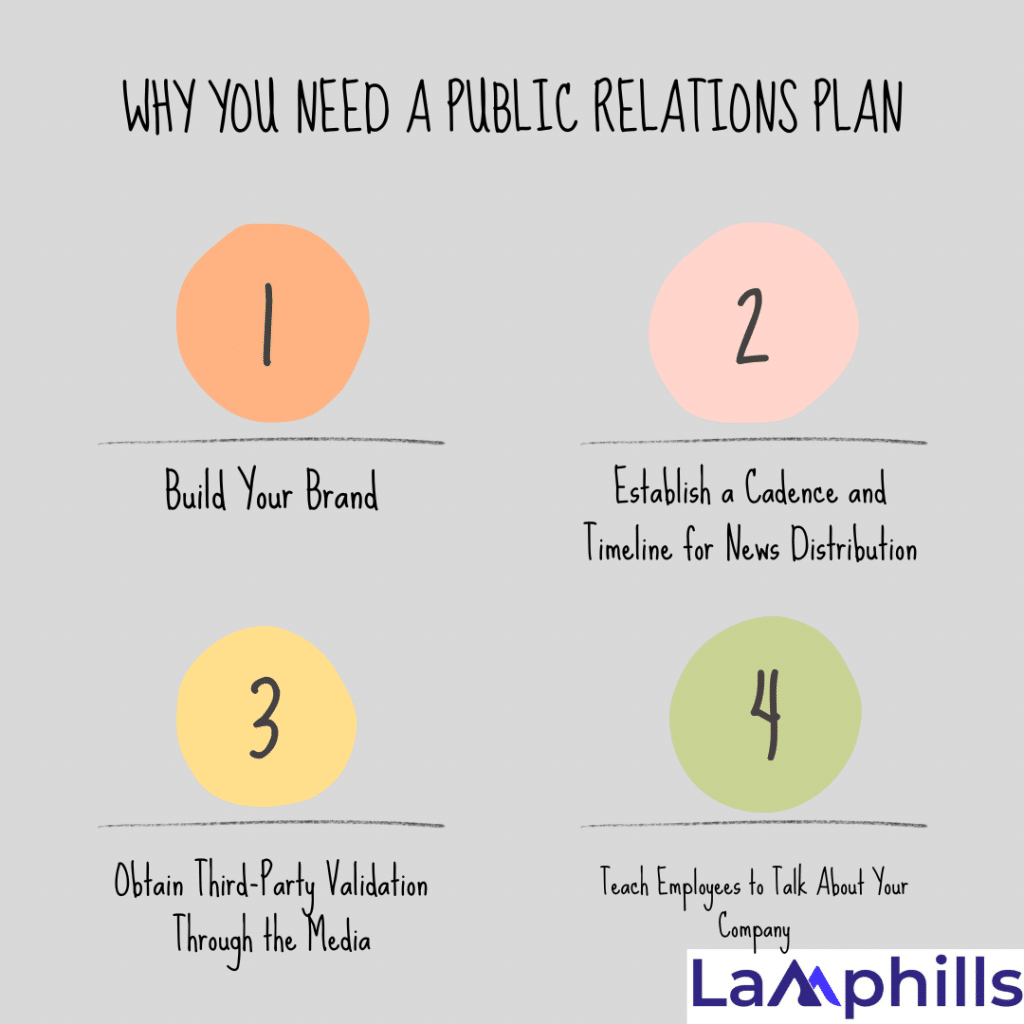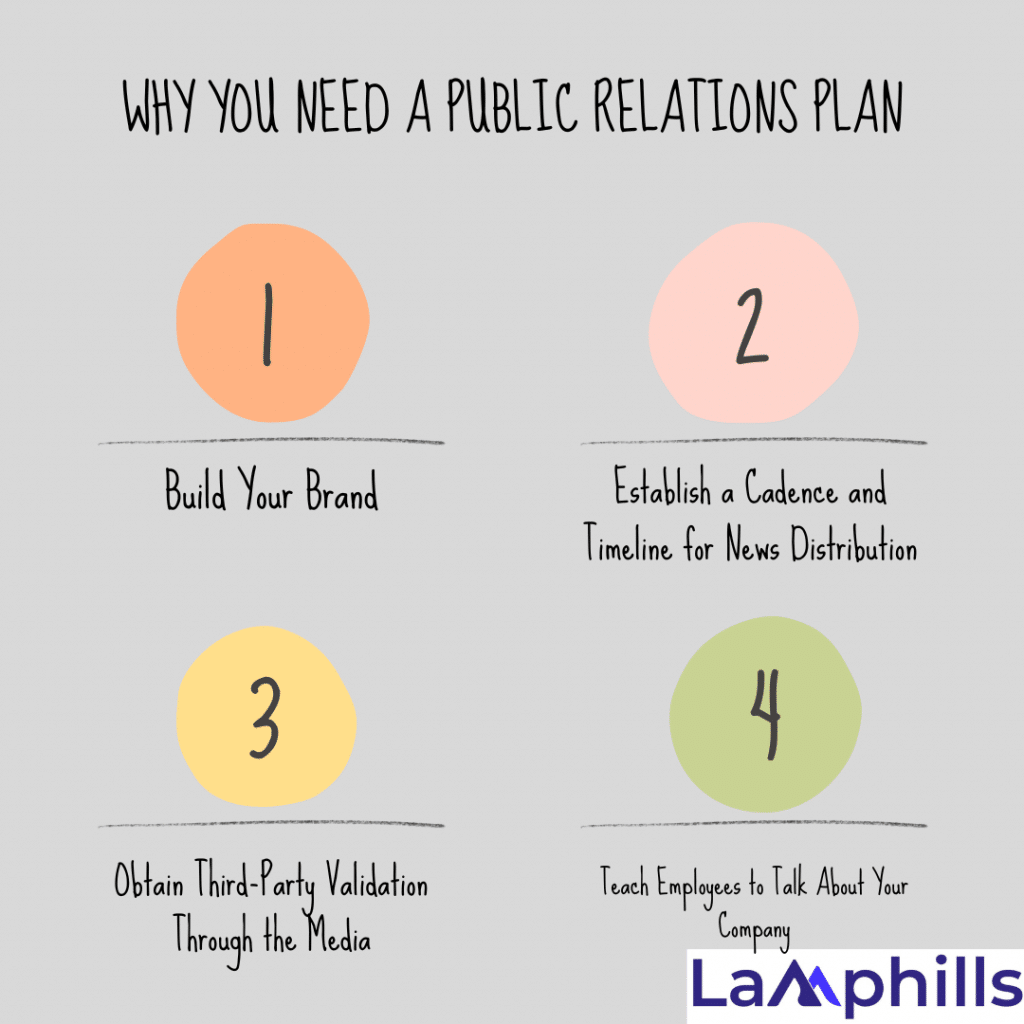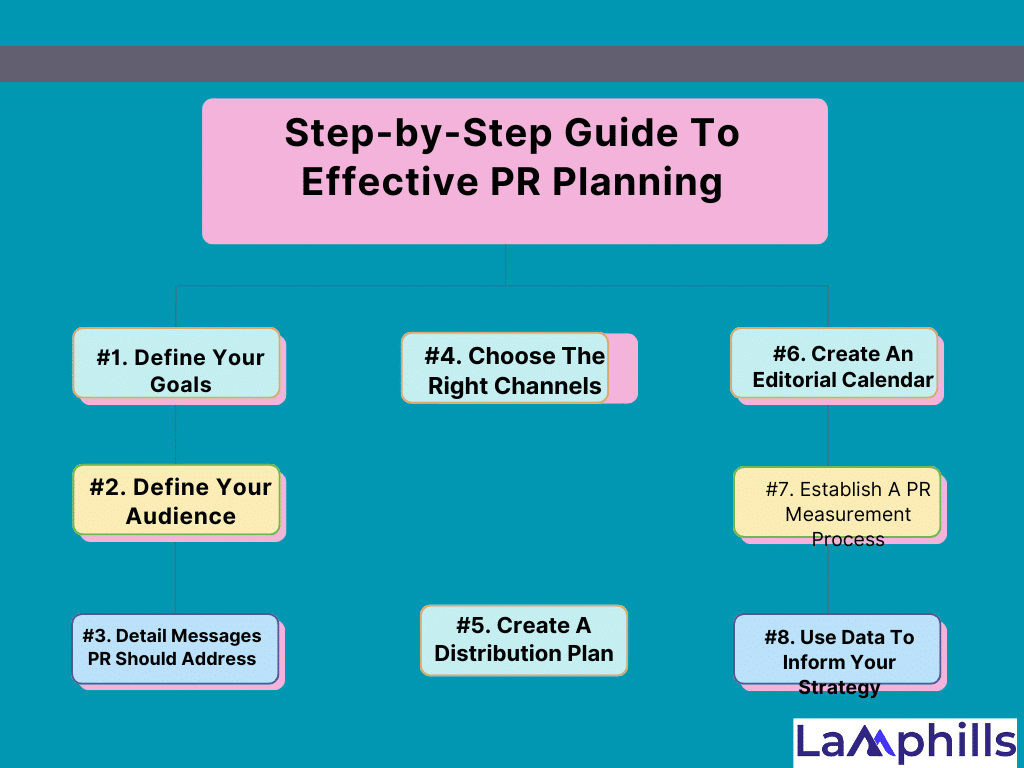A well-planned public relations plan is one of the most effective strategies to increase brand recognition. Rather than simply producing content and hoping for the best, you should have a strategy in place to help you achieve certain objectives. With strong PR planning, you can impact purchasing behaviors and consumer attitudes, cut through the noise, and present your business in the appropriate light.
If you took the effort to create an updated public relations strategy last year, you’re already in an excellent position. But don’t simply carry it over into the next year. You must periodically change your public relations plan to reflect the current state of buyers, rivals, and technology. And if you’re new to developing a PR strategy, you’re in luck! I will take you through the process step by step to help you get a jump on planning.
Key Takeaways
- A well-crafted PR strategy can rapidly increase brand recognition by having a clear action plan, influencing consumer behaviors, and positioning the brand positively.
- Even if you have a PR plan in place, it’s important to periodically update it to align with shifts in market conditions, consumer preferences, and technological advancements.
- A successful PR plan focuses on highlighting a company’s unique perspective and building strong relationships with media outlets to establish credibility with target audiences.
- PR strategies should start with well-defined goals and a deep understanding of target audiences, ensuring that messaging and tactics are tailored effectively to reach and engage them.
- Despite changes in the media environment, such as fewer journalists and shrinking newsrooms, PR is still crucial for managing brand reputation and leveraging third-party validation through media coverage.
What is PR Planning?

Think of a public relations strategy to be a framework for your brand’s communication initiatives. Setting goals, identifying target audiences, developing important messages, and choosing techniques to reach your audience are all part of the process. In my early days as a public relations specialist, I discovered that winging it was not an option—even the best ideas might fail without a strong plan.
PR planning develops strategies to assist brands and businesses in creating long-term value by inspiring, growing, and engaging in discourse, coverage, and broader culture. It also contributes to value protection in defensive or negative situations through strategic messaging formulation. Throughout the planning cycle, public relations planning performs many of the same key strategic responsibilities as advertising planning.
- Understanding current situation
- Imagining and defining goals
- Develop strategic approach, identify tactics and scope activity
- Stimulating, shaping and evaluating creative ideas
- Measuring, evaluating and valuing progress
- And works on brand positioning work, often through narrative development rather than brand definition or architecture.
PR planning performs these familiar roles in a different context—sometimes similar to an advertising agency, sometimes very different—working with clients outside of marketing and achieving goals related to investors, regulation, and broader social acceptance as frequently as sales, usage, or retention. In this setting, public relations planners must have a diverse collection of abilities, mindsets, and behaviors. There are seven distinguishing characteristics of PR planning.
What Is a Public Relations Plan?

A public relations plan lays out the goals, objectives, and techniques required to manage and improve an organization’s reputation and relationships with its target audience. It allows a corporation to become connected with its distinct point of view inside its market.
You may have lately heard that “traditional public relations is dead” or that “press releases don’t move the needle anymore.” The world is shifting, yet public relations remains critical for your firm.
A public relations (PR) plan focuses on something unique and newsworthy. Whether you’re attempting to influence major marketers, creating a story with some bullet points about a business with some messages, or posting the social influencer‘s thoughts on your channel, if it’s not newsworthy, it won’t work. What keeps clients interested for an extended time is also known as newsworthy. This is a story worth taking back your seats and noticing. A must-see story.
Pr professionals typically have years of experience and enough expertise to determine what type of news is worth their time and PR efforts.
What Are the Elements of a PR Strategy?
PR planning strategy typically includes:
- Goal Setting: defining clear objectives and outcomes that align with the overall organizational or personal goals.
- Audience Identification: Understanding the target audience(s) and their preferences, interests, and concerns to tailor messages effectively.
- Message Development: Crafting key messages that convey the desired narrative or information to be communicated.
- Media Relations: Engaging with journalists, bloggers, and other media outlets to secure positive coverage and manage any potential negative stories.
- Content Creation: Developing compelling content such as press releases, articles, blog posts, social media content, and multimedia materials.
- Crisis Management: Preparing for and managing potential crises or negative situations that could impact the reputation of the individual or organization.
- Monitoring and Measurement: tracking and evaluating the effectiveness of PR efforts through metrics like media mentions, sentiment analysis, email tracking, and audience engagement.
- Adaptation and Improvement: Continuously refining the PR strategy based on feedback, results, and changes in the environment to ensure ongoing effectiveness.
Comprehensive PR Planning Template: A Step-by-Step Guide
A well-structured PR plan is crucial for any brand looking to enhance its visibility, manage its reputation, and connect with target audiences. This comprehensive template will walk you through the essential elements of a successful PR plan, providing a clear framework to achieve your communication goals. Let’s dive into each component and understand how to craft a tailored PR strategy that drives results. Feel free to use this template below and start crafting your PR planning today!
#1. Goal Setting: Defining Your Objectives
Start by establishing clear, specific, and measurable goals for your PR efforts. These will guide the direction of your entire PR plan and help evaluate success later.
- Identify Key Goals: Determine what you want to achieve through your PR efforts, such as increasing brand awareness, improving reputation, or generating media coverage.
- Set SMART Goals: Make sure your goals are Specific, Measurable, Achievable, Relevant, and Time-bound.
For example, “Increase brand mentions by 20% over the next six months.” Example Goal: Increase positive media mentions by 30% within the first quarter to boost brand perception.
#2. Audience Identification: Knowing Your Target Market
Understanding your audience is key to tailoring your PR messages and ensuring they resonate with the right people. Define your audience segments to focus your efforts effectively.
- Demographic Details: Age, gender, location, income level, and occupation.
- Psychographic Insights: interests, values, and behaviors.
- Media Consumption: Identify which platforms your audience uses to consume information, such as social media, blogs, or traditional media.
- Example Audience Segment: Millennial consumers (ages 25-40) who value sustainability and engage with content on Instagram and industry blogs.
#3. Message Crafting: Creating Core Messaging
Your messaging should communicate your brand’s value and resonate with the needs and interests of your target audience. Consistent and compelling messages ensure that your brand story is conveyed effectively.
- Key Messages: Define 2-3 core messages that highlight what makes your brand unique and why it matters to your audience.
- Supporting Points: Use data, testimonials, and case studies to support your key messages.
- Brand Voice: Maintain a tone that aligns with your brand personality, whether it’s professional, friendly, or innovative.
- Example Message: “Our products are sustainably made, empowering consumers to make eco-friendly choices without compromising on quality.”
#4. Media Engagement: Building Relationships with the Media
Engaging with media is critical for gaining coverage and boosting your brand’s visibility. Develop a strategic approach to reach the right journalists, bloggers, and influencers.
Media List: Compile a list of relevant media outlets, reporters, and bloggers who cover your industry.
- Pitch Development: Create a compelling pitch that highlights a newsworthy angle or story about your brand.
- Press Releases: Write clear and concise press releases to announce major milestones, new product launches, or partnerships.
- Media Kit: Prepare a digital media kit with high-resolution images, company background, key messages, and contact details.
Example Pitch: “Hi [Journalist’s Name], I thought your readers might be interested in our new eco-friendly product line, which addresses the growing demand for sustainable living solutions.”
#5. Strategy and Tactics: Outlining the Approach
With your goals, audience, and messaging in place, it’s time to develop a strategic plan that outlines how you will achieve your objectives. This includes both long-term strategies and short-term tactics.
- Strategic Approach: Outline the overarching strategies, such as building brand authority through thought leadership articles or increasing social media engagement.
- Tactics: Specify the actions you’ll take, like hosting a virtual press conference, running a social media campaign, or collaborating with influencers.
- Timing: Create a timeline for each tactic, specifying deadlines for media outreach, content creation, and event planning.
- Example Strategy: Position the brand as a thought leader in the sustainability space by contributing articles to major industry publications and participating in podcasts.
#6. Budget Allocation: Managing Your Resources
A detailed budget ensures that you allocate resources effectively and track expenses throughout your PR campaign.
- Identify Costs: Include expenses like media monitoring tools, press release distribution services, event sponsorships, and influencer collaborations.
- Allocate Funds: Divide your budget according to the importance of each activity, such as prioritizing influencer partnerships over paid media placements.
- Monitor Spending: Regularly review your spending to ensure it aligns with your budget plan and adjust as needed.
Example Budget Breakdown:
- Press release distribution: $500/month
- Influencer partnerships: $1,500/month
- Event sponsorships: $3,000
#7. Monitoring & Evaluation: Measuring Success
To determine the effectiveness of your PR efforts, it’s crucial to monitor your progress and evaluate the outcomes against your original goals.
- Key Metrics: Track metrics such as media mentions, website traffic, social media engagement, and sentiment analysis.
- Tools: Use tools like Google Analytics, social media analytics, and media monitoring platforms to gather data.
- Report Findings: Create a monthly or quarterly report to present insights, analyze the impact of each tactic, and make adjustments to improve future results.
- Example Metrics: Track a 20% increase in social media mentions and a 10% boost in website traffic from press coverage.
#8. Crisis Management: Preparing for the Unexpected
Effective PR planning also includes a crisis communication plan to manage negative situations swiftly and minimize damage to your brand’s reputation.
- Crisis Scenarios: Identify potential risks, such as product recalls or negative reviews, and plan responses for each scenario.
- Crisis Team: Assign roles within your team, such as spokesperson, social media manager, and PR lead.
- Response Templates: Create pre-approved templates for media statements and social media responses to ensure timely and consistent communication.
- Example Crisis Response: “We are aware of the issue and are working to resolve it. Our top priority is the safety and satisfaction of our customers.
This comprehensive PR planning template equips you with the structure and guidance needed to create a strategic and effective PR plan. By following each step, from setting clear goals to managing a potential crisis, you’ll be well-prepared to build strong media relationships, deliver impactful messages, and achieve your brand’s PR objectives. Use this template as a guide to tailor your PR strategy to your brand’s unique needs, ensuring sustained visibility and reputation in the market.
Why You Need a Public Relations Plan

A well-thought-out public relations strategy not only helps you get media coverage, but it also influences how people perceive your brand. It can mean the difference between a crisis developing into a disaster or being handled with grace. One of my earliest public relations clients was a small technology startup. They were excellent but unknown. With a well-planned public relations strategy, we not only got them in front of major tech journalists but also positioned them as thought leaders. Within six months, they were quoted in major tech magazines, and queries from possible investors began to pour in. So, you need pr planning strategy to help you:
#1. Build Your Brand
Marketing is distinguished by its strong messaging, discipline, and consistency. Once you’ve established a strong point of view, you must continue to promote it until it becomes synonymous with your brand. A public relations plan gives you the tools you need to execute consistently.
Before you begin drafting press releases or pitching media, you must first develop a specific plan. That way, you’ll be sending a consistent message to your audience, ensuring they know exactly what you stand for. Every interaction that a person has with your firm is an opportunity. It can either be a positive opportunity (brand equity earned) or a bad one (brand equity lost). Naturally, you want to stack favorable opportunities.
#2. Establish a Cadence and Timeline for News Distribution
Timing is a crucial aspect of any effective public relations strategy. You wouldn’t want to announce all of your news in one month and then go silent for the rest of the year. A regular drumbeat of buzz is preferable; it will help you get your message out there consistently and keep your name at the forefront of the market.
#3. Obtain Third-Party Validation Through the Media
It is also crucial to acquire third-party validation by having your company’s name in the media outlets via an interview, contributed article, or mention in a larger story. You’re This effectively demonstrates that a credible source believes your organization is also credible. It’s also a chance to reach a fresh audience outside of your owned channels.
#4. Teach Employees to Talk About Your Company
As your business grows, your public relations strategy will serve as a framework for any employee who needs to speak publicly about your organization. This includes executives who are interviewed, as well as marketers who write contributed pieces or apply for awards. Furthermore, in a crisis communication situation, it is critical to have a document outlining what your firm wants to say to the outside world and who can say it.
Before You Start Developing Your Plan

Before you begin developing your public relations strategy, conduct thorough company research. The public relations plan should not be viewed as a blank page that needs to be filled out. You most likely have several insights from your current position from which you may and should learn. Here are some resources that you might check out:
#1. SWOT Analysis
SWOT: strengths, weaknesses, opportunities, and threats. It is a planning tool and strategy for concretely defining what has to be done to build a company. SWOT analysis can be utilized by both associations and individuals. One of the primary goals of conducting a SWOT analysis is to identify the elements that are impeding progress toward specific objectives. With a fairly simple gesture, you can create a map of strengths, weaknesses, opportunities, and threats. It often involves testing and weighing up many different factors.
#2. Brand Monitoring
Media monitoring keeps you informed about what others are saying about you, your company, and your products on social media. You can also monitor your competitors, as well as your subject area and industry as a whole. You can draw a variety of conclusions and apply the knowledge you receive from social media monitoring—we’ll go over that further in a bit.
#3. Resources
To set the bar correctly, you must manage your resources. Do you have access to a journalist network? How do you distribute your content? Can you follow up on the results? A sensible and efficient approach to getting that information is to employ an all-in-one communications system platform like Mynewsdesk.
Step-by-Step Guide To Effective PR Planning

Typically, c-level managers do not see the value in supporting a project unless it favorably adds to the company’s overall goals. Identify your company’s business objectives and ambitions. Now that you’ve investigated your current scenario, let’s get started with the actual PR strategy. When developing your PR strategy, you must tailor it to your specific business and market. Not everyone is suited to working in public relations. Take some time to examine how you want to use public relations and what precise actions you believe will be most effective in developing relationships with your target audience. Let’s go through it step by step.
#1. Define Your Goals
It all begins with your ambitions. Before you can generate any buzz, you need to understand why you’re doing it. Your goals should be SMART (specific, measurable, attainable, relevant, and time-bound). For example, when I worked on a product launch for a wellness business, we aimed to acquire 20 media placements in three months. It was specific, had a deadline, and required us to work efficiently.
In other words, having defined objectives is critical for your PR job so that you can track and measure your progress (more on metrics later). How else will you know you’re on the correct track? Consider the goal of your public relations activities while deciding on your objectives.
- Is it to attract new customers?
- Increase brand recognition?
- Entering a new geographic market?
- Launching a new product or service?
- Employer branding?
These can be scaled based on where you are in your PR journey, your resources, and your available money. Perhaps you just want to develop a specific plan for a product launch? Or is it merely for digital presence? In either case, it is up to you to decide whether your objectives should be broad or specific. Adjust the targets to be more manageable for you and your team. Once you’ve determined why you’re communicating, the rest will be much easier. It will assist you in deciding who you want to target, how, and when.
#2. Define Your Audience
Who do you want to reach? Are they tech aficionados, environmentally conscious millennials, or finance C-suite executives? Early in my career, I made the error of thinking that the larger my audience, the better. However, I rapidly realized that aiming for everyone frequently means reaching no one successfully. Concentrate on the individuals who are most likely to be interested in your message.
When it comes to public relations, you should be aware of two major audiences. The people you want to share your message with first (journalists and other influencers), as well as the people they share it with later (readers, followers, etc.). Let’s look deeper into how they differ and how you might approach them differently.
Media, journalists, and other influential figures. Being relevant is essential for developing media relationships. However, you should also make it easy for them to spread your brand’s news and tales. What resources do you now have that will enable you to capture the attention of the media and journalists? Create strong media relationships to guarantee that your content is picked up by the appropriate person when you have something to say to the target audience. When creating your public relations campaign, you should understand your target audience’s demands and behaviors. Knowing this allows you to develop relevant and compelling content, ultimately building strong, loyal relationships.
#3. Detail Messages PR Should Address
Now that you know what you want your communication campaign to accomplish, it’s time to think again about your audience. Your key messages are the backbone of your PR plan. They ensure consistency across all communications, from press releases to social media posts. Each message should be simple, clear, and align with your brand’s voice.
- How will your efforts involve (not interrupt) the audience?
- What content can your company offer to help or entertain your audience that relates to their daily lives and connects to your strategic PR goal?
Compile the list of topics and craft relevant messaging.
TIP: Put yourself in your audience’s heads and ask: ‘Why would I care about [insert your topic/message]?’ If you struggle to find the answer, choose a new topic or message.
#4. Choose The Right Channels
The traditional channels for PR have been events or press releases, and those are, of course, still important. But in today’s digital landscape, the playfield has changed, and you need to adapt your PR efforts so that people can build relations with you online as well. Choosing the right content for the right channel will help you reach the right people at the right time with the right message. Yes, “right” is the key ingredient here.
A. An online newsroom
A great way to reach and build relations with the media, your audience, and other important stakeholders in today’s digital landscape. If you want further insights on how to catch the attention of journalists, have a look at our press release guide.
B. Social media
It is no secret that Social media has become one of the most important tools when it comes to PR. Social media gives you the chance to be personal, engaged, and real with your audience. Through instant feedback about your content, you will quickly learn what people like and dislike.
C. SEO and strong domain
Working with SEO puts you in the driver’s seat of your digital PR strategy. Knowing your audience can ensure that you are top-of-mind for important keywords. Build your own strong domain or take advantage of other publishing solutions with high domain ranking. This ensures that the content you put out through Mynewsdesk will be highly favored by search engines like Google and will have a much greater chance of ending up early in their search lists than if you posted the same content on a different platform. Did you know that Mynewsdesk has one of the strongest SEO domains in the world?
D. Event Online/Offline
Events are a good way to interact with your audience. Both you and your audience get something out of it – which is a key to building relations. One great thing about today’s digital opportunities is that you can attend gatherings without having to physically go places—another cost-effective way of gathering important insights, to say the least.
E. Online articles and guest posts
Collaborate with others by offering to guest post content with valuable insights and thoughts on other platforms. This way, you can establish your brand as a trusted advisor, and you get valuable backlinks, increasing traffic to your digital platforms.
F. Influencer marketing
We are all aware of the impact influencers can generate. They have the power to influence thousands of followers with their own opinions. Including influencer marketing in your PR plan can definitely provide you with an extra edge.
#5. Create A Distribution Plan
Your target demographic prefers to communicate via email, social networking platforms, push alerts, and so on. They also prefer specific devices, such as a smartwatch, phone, tablet, laptop, or desktop. It would be beneficial to communicate with your target audience where they consume content. If you don’t, your audience will miss your message, no matter how relevant it is. Remember to tailor your message to the intended format, duration, and tone of the chosen digital channel.
#6. Create An Editorial Calendar
When creating your PR plan, you will save time by arranging a schedule and plan for your efforts. Who is doing what and when? Using the “5 W’s and 1 H” method is an easy and effective way to structure your PR efforts. It gives you a clear view of what kind of content you want to create—for who, where, and when – and how they will meet the objectives you have determined.
Did you know that most tools allow you to pre-schedule the send-outs of your content piece? This is a great way to plan. It also gives you room to take action on something that just came up and readjust the timeline for your other content.
#7. Establish A PR Measurement Process
One of the best selling points of digital communications, unlike most traditional advertising or marketing efforts, is that it can be more comprehensively measured, making it much easier to know if your efforts have the desired effect.
Start by understanding what media measurement categories are most important to your organization. Could it be one of the following:
- Brand awareness?
- Return on investment?
- Leads?
Now, when it comes to specific metrics to use, the five most frequently used parameters may include:
- Subscribers – the number of people who engage with your content regularly.
- Reach – the amount of organic traffic you receive to your blog.
- Mentions – the amount of buzz your campaign is generating.
- Sales pipeline and lead generation—the number of prospects and the number of new deals generated.
Make it as clear as possible when identifying what you’re assessing (category) and how (metrics). Recognize that some categories (such as impressions and reach) are easier to quantify than others (such as brand perception and return on investment). But don’t choose categories solely because they’re easier to measure. In brief, choose the KPIs that are most closely connected with your aims.
This is because the measurement methods you select must be intimately tied to your strategic objectives. For example, if your strategic aim is to increase the number of email subscribers, metrics such as likes and comments will not inform you how effective you are. However, if your goal is to improve your brand recognition, the number of followers and interactions could be helpful metrics, but so could third-party surveys.
#8. Use Data To Inform Your Strategy
Don’t just report the data; use it to improve your communication approach. Make an appointment in your calendar (at least once a month) to delve into the data on a micro and macro scale.
Another critical step is not to limit your analysis to internal numbers alone. New data and patterns will emerge from outside your team. Remember to speak with other departments to hear about the changes they are experiencing. Also, review external sources that speak to trends in your industry and about your audiences. As a result, use a comprehensive analysis to inform and update your strategy, expanding on successes and tackling newly discovered obstacles as they arise.
What is a PR planning sheet?
A public relations (PR) planning sheet is a document that outlines a company’s strategy for managing its public perception.
What are the models of PR planning?
These four PR models — the press agentry, public information, two-way asymmetrical, and two-way symmetrical — are essential building blocks for crafting comprehensive communication strategies that cater to an organization’s diverse needs.
How does public relations fit within a marketing strategy?
Public relations is a distinct component of a marketing strategy, designed to support and enhance marketing efforts with consistent and coherent messaging across all forms of communication.
Can small businesses manage public relations without a dedicated department?
Yes, small businesses can handle PR with part-time employees or outsource it on an as-needed basis, ensuring a thoughtful and cohesive PR strategy is in place.
Conclusion
Creating effective PR planning might seem daunting, but breaking it down into manageable steps makes the process so much easier. From setting clear goals to crafting the perfect message, the time and effort you invest now will pay off in spades. Remember, PR isn’t a one-time effort—it’s an ongoing process of building relationships and telling your brand’s story.
Now, it’s your turn. Grab those templates, start planning, and watch your brand’s presence grow. And if you have any questions or stories of your PR wins, drop them in the comments below—I’d love to hear from you!






